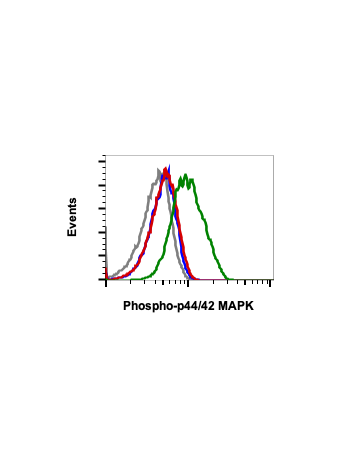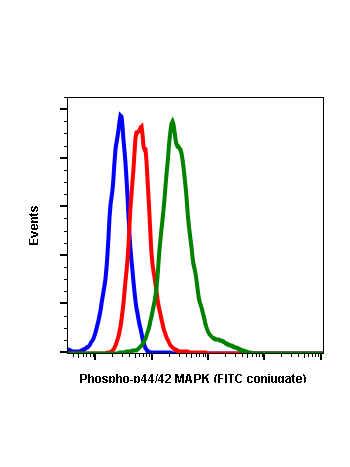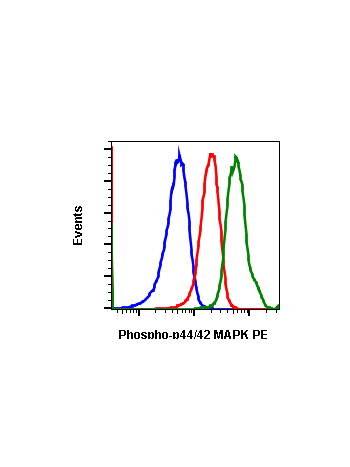Phospho-p44/42 MAPK (Erk1/2) (Thr202/Tyr204) (A11) rabbit mAb APC conjugate
Human Erk1 and Erk2 Ser/Thr kinases share 84% sequence identity and nearly all functions. These MAP kinases are activated in response to mitogens and growth factors as part of the Ras-Raf-MEK-ERK signal transduction cascade(1-3). This pathway regulates cell survival, differentiation, adhesion, cell cycle progression, and many other cellular processes. Upon phosphorylation, Erk1/2 translocate to the nucleus to activate transcription factors including c-Fos, Elk1, Ets1, and SP-1 (4,5). There are more than 175 known cytoplasmic and nuclear substrates of Erk1/2. The Erk1/2 cascade is upregulated in many human cancers, even when oncogenic mutations are not found. Multiple small-molecule inhibitors of Erk1/2 have been developed, including ones targeting the ATP-binding site either competitively or irreversibly (6).
| Applications | Flow Cytometry |
|---|---|
| Clone | ERK12T202Y204-A11 |
| Format | APC |
| Validated Reactivity | Human, Mouse |
| Cross Reactivity | Predicted to work with mouse, rat, and other homologues. |
| Clonality | Monoclonal |
| Immunogen | A synthetic phospho-peptide corresponding to residues surrounding Thr202/Tyr204 of human phospho Erk1/2. |
| Formulation | PBS, 0.09% NaN3, 0.2% BSA |
| Isotype | Rabbit IgGk |
| Preparation | Protein A |
| Recommended Usage | For flow cytometric staining, the suggested use of this reagent is 5 µL per million cells or 5 µL per 100 µL of staining volume. It is recommended that the reagent be titrated for optimal performance for each application. |
| Storage | 2-8ºC |
| Pseudonyms | Mitogen-activated protein kinase 3, MAPK3, ERK2, p44-MAPK, PRKM3, Mitogen-activated protein kinase 1, MAPK1, ERK1, p42-MAPK, PRKM1, PRKM2 |
| Uniprot ID | P27361 P28482 |
| References | 1. Blagoev B, et al., 2003, Nat Biotechnol, 21:315-318. 2. Thelemann A. et al, 2005, Mol Cell Proteomics 4:356-376. 3. Morandell S., et al., 2008, Proteomics 8:4383-4401. 4. Ramos J.W., 2008, Biochem Cell Biol 40:2707-2719. 5. Nakano H., et al., 1998, Proc Natl Acad Sci U S A. 104:19837-19842. 6. Roskoski Jr R. 2012, Pharmacol Res 66:105-143. |





